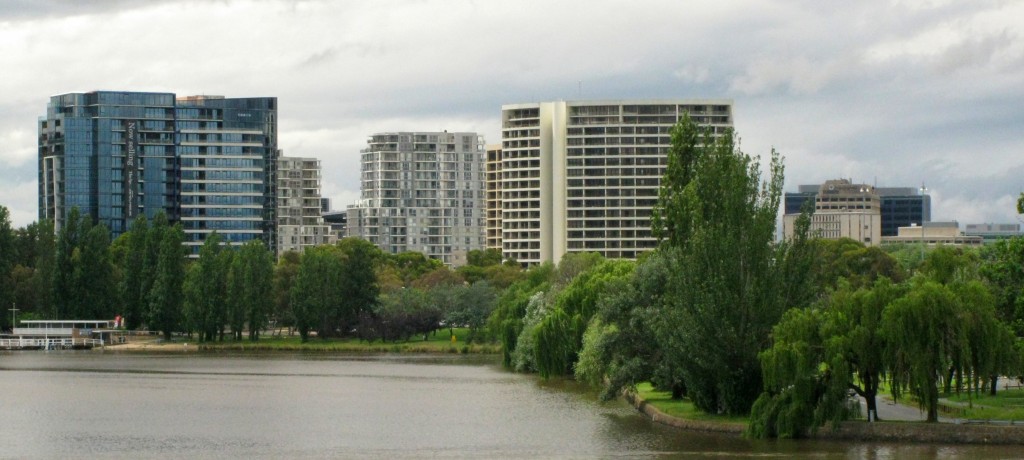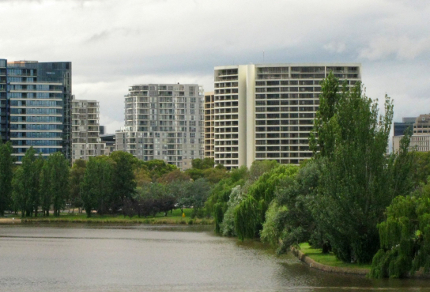At 5:15 a.m. on a Sunday morning, my only companions on the Ross River Parkway were birds – peaceful doves, little corellas, rainbow lorikeets, mynas, stuttering white-gaped honeyeaters, shrill magpie-larks. Palm leaves hung in fringed curves against pale blue sky like a frozen moment caught above pastel houses. Dew silvered lawns, and ground mist floated over meadows east of the river. The peaceful drone of cicadas vibrated throughout the parkway, golden-headed cisticolas plopped out their buzz-plink calls, and blue-winged kookaburras punched holes in the morning air with harsh brayings and chortles. A pair of black ducks splashed in an expansive puddle, and the rising sun pushed shafts of heat out over the river valley. Such was a budding Dry Tropics morning in rain-softened Townsville.
At 9:25 a.m., Vilis and I were in the air en route to Brisbane and then Canberra. Our approach to Brisbane offered views of the South Queensland coast, muscled, murky rivers, and flooded green polygons of lawn within that city recently plagued by torrential rains and flash floods. From Brissie, a Qantas Link flight carried us inland over green rangeland and forest, with no obvious sign in sight of the drought that has held the southwest region of the state in its grip for the past decade.
Since cloud obliterated the view for much of our flight time, I immersed myself in Sean Carroll’s Into the Jungle – the opening chapters of which had inspired me to begin this blog nearly a year ago – and revelled in the palaeontological adventures of Roy Chapman Andrews in Mongolia, where he led field crews from the American Museum of Natural History to outstanding discoveries of fossilized dinosaurs (including eggs) and mammals; in the intuitive awareness of Marjorie Courtney-Latimer, who realized that a beautiful blue fish with armor-like scales dragged up from the depths by a South African trawler was no ordinary fish (it turned out to be a coelacanth, a fish thought to be extinct for millions of years); in the curiosity of Johan Ruud, who discovered that the ice fish of Antarctica are the only vertebrates which completely lack red blood cells – an adaptation to life in extremely cold Antarctic waters; and in the determination and insight of Tony Allison, whose African medical studies linked the presence of the sickle-cell anemia gene to resistance to malaria in individuals possessing one sickle-cell chromosome and one normal one.1 Finishing the book seemed a fitting symbol of finishing our time in Oz.
In mid-afternoon, Canberra – located within the enclave of the Australian Capital Territory surrounded by New South Wales – greeted Vilis and me with its continental climate, providing a delightful and refreshing change from the steamy heat of Townsville. I spotted maples and oaks growing as street trees, and the thought struck me that I could have been in Canada. Immediately upon our arrival in the Central Business District (CBD), we perceived the city as being remarkably spacious and green, possessing none of the racy, cluttered atmosphere of Melbourne. Major downtown streets were graced with tree-lined medians, and buildings shorter and brighter than those in Melbourne’s CBD flaunted large expanses of glass.

Canberra and Lake Burley Griffin (© Magi Nams)
After a quick supper, we walked from Novotel to the Australian National University, where Vilis registered for the week-long meeting of the Ecological Society of Australia. Then we strolled through parks bordering Sullivan’s Creek. Not having taken my binoculars with me, I nonetheless chalked up sightings of gloriously red and blue crimson rosellas, an Australian raven, mynas and magpie-larks, noisy miners, Australian wood ducks and black swans along the creek, pied currawongs, galahs, and sulphur-crested cockatoos. A half dozen white-winged choughs – a species I was hoping to see – paraded across the park path practically at our feet, their red eyes, arched beaks, and white at the base of folded wings giving away their identity. After muttering to Vilis that I should have brought my bins, I completely changed gears and commented to him, “But it’s nice to sometimes go for a walk without being obsessed by birds.” Immediately upon speaking those words, I clutched his arm and pointed out an eastern rosella with a brilliant red head and batik-like dorsal plumage perched on a chainlink fence only a few metres away. We burst into laughter and walked on. I noted willie wagtails, crested pigeons, red wattlebirds…

White-winged Choughs (© Magi Nams)
Reference:
1. Sean B. Carroll. Into the Jungle: Great adventures in the search for evolution. 2009. Pearson Education Inc., San Francisco, California, Chapter 5 – Where the Dragon Laid Her Eggs; Chapter 7 – Miss Latimer’s Extraordinary Fish; Chapter 8 – A Sickle-Cell Safari; Chapter 9 – In Cold Blood: The Tale of the Icefish.


